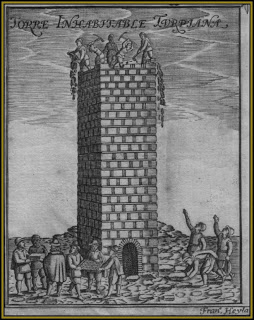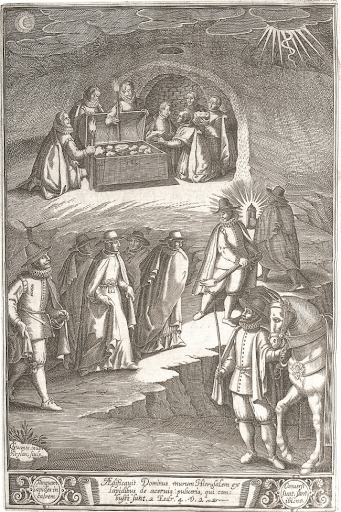
On March 18th 1588
A box with a parchment and some relics was unexpectedly found when demolishing the Turpian Tower. The parchment was written in three languages: Latin, Arabic and Castilian Spanish. The relics were. “An image of Mary the Virgin painted on a small wood panel; painted in a very old style, in Egyptian dress (oriental), holding the Child in her arms”, as described by the Marquis of Estepa; a piece of the cloth the Virgin wiped her tears with, on contemplating his Son’s crucifixion, and a bone from St. Stephen, one of the very first Christian martyrs.
On February 21st 1595
Some underground ovens for slaking lime from Roman times were found by two treasure hunters, Francisco Garcia and Miguel Lopez Muñoz, in Valparaiso Mount. St. Cecilius mortal remains, as described in Latin letters carved on a metal plaque, were found in one of these ovens.


1598
Don Pedro de Castro, Granada’s Archbishop, provided four chaplains to minister cult in this sacred place. They were accommodated in a small house next to the Holy Caves.


April 30th 1600
The authenticity of the relics is declared by a Council presided by Don Pedro de Castro.
1607
The old name of “Mount Ilipula, or Ilipulitano” is replaced by “Sacromonte” (Sacred Mount).

1609
Construction works at the Abbey start under the direction of Pedro Sanchez, a Jesuit priest and architect. A Foundation for the Abbey was established with one Abbot and 20 Canons.
1610
Sacromonte Abbey’s Tridentine Seminary-College was founded, with the name of St. Dionysius the Areopagite.
Don Pedro de Castro is commissioned Archbishop of Seville. Because of his departure, the works on the Abbey’s main project come to a halt.

1615 – 1617
The Choir in the Collegiate Church, one of its main features, was made by Francisco Diaz del Rivero.
1618
The students of the Seminary-College could get their studies accredited and become ordained priests.

On December 20th 1623
Don Pedro de Castro dies. This also means a severe shortage of the funding he provided for the works at the Abbey.
1624
The Sacromonte site receives the visit of King Philip IV, his Patron.
1646
February 1st is declared St. Cecilius holy day.

1682
The leaden books, which were found near the relics, were declared false by a Vatican Council presided by Pope Innocentius XI.
1698
Jose de Risueño makes the wood-carved sculpture of the Christ of Consolation, who is popularly known as the Christ of the Gypsies.


1711
Construction works at the Abbey resume following the financial support of Archbishop Don Martin Azcargorta.
1752
Pope Benedict XIV concedes the Academic tenures of Canonical and Civil Laws, Ecclesiastical History, and Arabic, Greek and Hebrew Languages.

1845
The Law School is closed and, therefore, the College loses the category of University. It is transformed into a High School for gentlemen.
1870
Civil Law classes resume, however, without any official recognition.

1895
The New College building and St. Dionysius Neo-Gothic Church are completed.
1919
The Association of the College’s former alumni is founded.


1929
The Museum at Sacromonte Abbey is opened.
On May 14th 1939
The brotherhood of the Christ of Consolation was officially founded, and consecrated by the Abbot Don Jose Jimenez Casqet.

1975
St. Dionysius College is closed.
2000
On June 28th 2000, the Vatican returns the original “Leaden Books” to the Abbey
On September 21st 2000, a great fire burns the roofs of the New College.

2010
The new Museum opens.

On September 15th 2015
The Sacromonte Abbey Foundation is founded by Don Francisco Javier Martinez Fernandez, Archbishop of Granada.


2017.
Rehabilitation of the monument main facade
2018.
Outside rehabilitation of the Sacred Caves



 English
English

